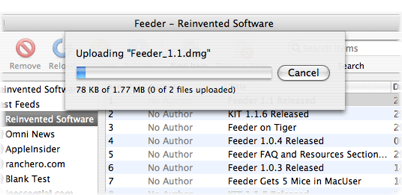That Intel Announcement
June 8th, 2005 by Steve HarrisSadly, I couldn’t attend WWDC this year – I was about $3500 short (i.e. all of it) and not being overly keen on spending $999 on leasing the transition kit I’m going to need an Intel Mac in the next 18 months or so, which means I can’t really expect to be going next year either. Always good to know where you stand!
So what of the switch to Intel? Naturally, I gasped in horror when the rumours proved to be true, but after some deep breaths and even longer spent in a darkened room I’m warming to the idea. I haven’t seen Mr Jobs do his thing yet, so it can’t be RDF, unless it’s seeping subliminally through my RSS feeds. Overall, and performance issues aside (consider the lack of optimisation, PPC emulation and no AltiVec support), things should be no different. Mac OS X will still be Mac OS X and it won’t (officially / legally, at least) run on anything that hasn’t got an Apple logo stuck on it. RISC chips such as PowerPC may perform much more efficiently at lower clock speeds than CISC chips, but try telling that to the marketing department. Additionally, I would imagine almost everyone has had enough of seeing PowerPC roadmaps redrawn on an annual basis because of manufacturing problems, corporate meltdowns, Mercury retrogrades, etc.
Like many other developers my applications won’t need anything particularly special done to them apart from recompilation, packaging and testing on the aforementioned Intel Mac. I can see a few issues, but nothing devastating. The developers most affected will be those who do low-level funky stuff that will be affected by a change in architecture (big-endian vs. little-endian, for example). The cross from 680×0 chips to PowerPC was almost a seamless experience and this should be similar but different. Similar in the sense that you would have emulation of the “old” chip on Intel and different in that the hardware transition will take much longer and could start from the bottom up rather than the top down thanks to deficiencies in Intel’s 64-bit SMP (Symmetric Multiprocessing) support and a lack of G5 laptops. I also think it will be much less painful than the transition to Mac OS X, which felt like being a full-time beta tester for the first year or two.
So is this simply Apple abandoning over 10 years of PowerPC (incidentally it was my interest in the introduction of PowerPC that made me buy my first issue of MacUser UK, back in ’94) or could there be advantages beyond the ones that only interest accountants? Well yes, if you consider that the Mach kernel (upon which OS X runs) is designed to run multiple operating systems simultaneously (think Classic) and that Windows would require no hardware emulation to run on a MacTel. I think you will agree that would make switching to Mac a whole lot easier and considering the endless troubles PC users seem to be having with the security and stability of Windows, Apple should have a captive audience there. What’s more, things that are low-level and funky might not be quite so difficult to port from other Intel-based platforms to OS X.
Overall it’s a big announcement, which by its very nature can send your MacEmotions into a spin, but in reality it won’t make much difference. The transition will be “fun”, could cost some people quite some money, but it will be nothing compared to the transition to OS X.

